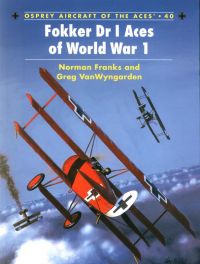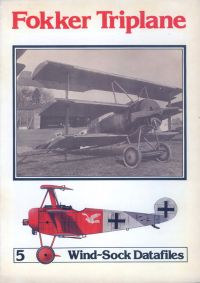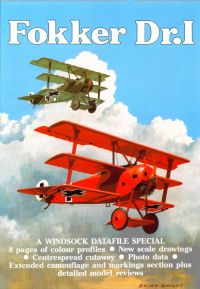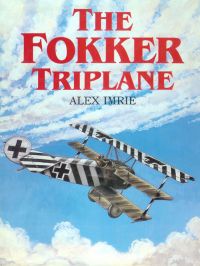Merit International LLC | 62403: 1/24 Fokker Dr. I
Reviewed by Kevin Williams

Much to my surprise, my first impressions of this kit were quite favorable. Tooling, in general, seems quite decent, even though simplification of many parts seems to be the order of the day. Overall proportions of main components (wings, tail and fuselage) look very good, and I believe will capture the look of the iconic Dr. I quite well.
Note
Despite having written several reviews already for this fine site, it never really occurred to me exactly who these reviews are written for. It now seems certain to me that these reviews are not written exclusively for the hardcore purists amongst us, but rather for everyone from the novice to the most experienced and serious modeler, therefore my summarizations will reflect overall kit appeal, rather than nuts and bolts minutia about overall accuracy and fidelity of detail. Though overall accuracy issues will not be discussed at length here, I will not hesitate to offer my views of specific and obvious errors. For the most part, I’ll let the images speak for themselves, and there are quite a few of them.
General
First, we’ll take a cursory look at the information that’s provided separately as instructions and painting/decal placement guide overview.
Instructions
Instructions are a pretty straightforward affair, being pictographic in nature, as is standard.
Painting/decal Placement Guide
A two sided painting/decal placement guide is included, one for Manfred Von Richtofen (152/17) Jasta 11 (this is the same aircraft that was preserved after WWI, but was subsequently destroyed by allied bombing raids during WWII, a tragic loss of a historically significant machine) and the other depicting one of two Dr.I's flown by Friedrich (Fritz) Kempf, (213/17 or 493/17, but probably 493/17) Jasta Boelcke.
Tool brochure
Also included, is a brochure pushing Merit (Trumpeter) tools, and there's some pretty cool stuff here that I may well be ordering in the future, items that will no doubt come in very handy for this hobby passion of mine.
Decals
Decals, for the most part, look OK. No printer name is present, so I suppose it's safe to assume these are typical Trumpeter quality. Flight instruments are given as decals, but look rather poor, so replacements will probably be needed, same for what I presume are the (8) Axial propeller logos, which bear little or no resemblance to actual Axial logos. Instructions show these as being added to both front and rear sides of propeller, which is totally incorrect, as they would only appear on front side. No decals are given for struts either, even though they'd be clearly visible on a model of this size, the exception being where the struts are painted as a result of personal markings of an individual pilot. Data plate decals (for starboard engine cowl side) are also nowhere to be found, and such is also the case with tail numbers. Weight tables are included however.
(One thing that that I certainly did not expect, is the inclusion of what appear to be a complete set of fuselage and upper wing surface(s), streaked olive finish decals. It's highly doubtful that I'll use these, but a nice touch just the same.)
Note: On virtually every Dr.I image I've ever seen, there's a period after Fok (on fuselage sides), but there is none on this sheet.
Photo Etch
One P.E. set is included, with two Spandau cooling jackets, as well as eight elevator/aileron control arms. Apparently, the two arms for the rudder are left up to the modeler to source elsewhere.

Wings
Wings are molded as typical with upper and lower halves joined horizontally. Perhaps it was for this reason that Merit chose not to supply the leading edge stacking pads on any wing segments, but they are certainly not there. One nice touch that I was initially happy to see, was the inclusion of the spar data viewing "window", until I realized it's in the wrong position. Window is virtually smack in the middle of the wing cord, but actual spar is located much further forward within the Dr. I wing. Overall impression of surface ribbing is good, however the erroneous dogtooth plywood veneer simulation on wing bottoms will need to be sanded away, as this is incorrect. One nice touch here, is the splitting of the main wing struts into four separate pieces. This should make painting/assembling wings a much easier task. Missing from the upper middle wing section, is the fuel filler cap (port side), as well as MG blast plates, though I cannot confirm that these were always installed. The fuel gauge fairing is present, but the trough behind it is bogus, as the fuel gauge was installed almost even with the fuselage top, so this trough would be unnecessary and serve no function, and besides, fairing itself is too far aft anyway. Also missing are the several prominent "Fokker nuts", but I really wouldn't expect them anyway. From Wingnut Wings, yes, from anyone else, no.
Along with the wings is the inclusion of the lower wingtip skids, and I believe these are acceptable as given.
Fuselage
Overall impressions of fuselage is pretty good, but not without a couple of minor issues, one being ejector pin marks in awkward to fill or otherwise visible locations within cockpit area. The cockpit coaming is represented as one continuous ring, but in reality front half is padded, whereas rear half is not, so purists may want to correct/improve that. The most egregious no-no I see on fuselage, is the molding of the fabric stitching on both fuselage half bottoms. I see no easy way to resolve this but to shave/sand it all off and replace with a simulation after fuselage seam is cleaned up. Also, the reinforced openings in rear fuselage for elevator and rudder control cables, seem a bit large to me, but that's certainly not a deal breaker. These are simple fabric reinforced fabric openings, not portholes. The purists will also want to open them up so as to install said control cables and turnbuckles. The forward fuselage area where the trapezoidal plywood section is located, is simulated in an overly pronounced way to my eye, but that may just be a weird optical illusion.
Cockpit
This well maybe the high point of the kit, though again, inaccuracies/fictitious details abound. Control stick and rudder assembly look quite decent. Instrument panel board is not bad at all, with magneto looking the part. Once again, I was quite pleasantly surprised to see the inclusion of a more or less complete tubular framework for interior (without ejector pin marks all over the place even), and once built, should look pretty effective, though no rear gun supports are supplied. Missing from the interior are the oil gauge and ignition switch (for lack of a better name, possibly a spark advance, I'm not real sure), but by far the largest omission of all, is the complete absence of the quite visible reinforced trapezoidal plywood that extends from cockpit rear to engine mount. Also the bulkhead (not really a bulkhead, but canvas laced to structural tubing) behind pilot seat, is given, but the lacing is incorrect, being perpendicular to tubing as opposed to the correct angled lacing, but otherwise looks decent and includes the reinforced openings for rudder and elevator control cable passage. Throttle is quite busy, but again is somewhat simplified. No seat belts are included, though seat looks OK to me, certainly acceptable anyway. Kit includes what appears to be a map case, though I cannot verify if these were ever installed as standard.
Landing Gear/Wheels
Main landing gear is comprised of the central aerodynamic fairing, struts and wheels. Central fairing seems OK, but many of the tabs molded onto bottom surface will need to go. Wheels are representative (sort of), of actual Fokker wheels, but appear quite flat and lifeless, not really capturing the shallow conical effect one would expect to see of the canvas wheel covers. Struts themselves look acceptable. Tail skid is offered up as a single blob of plastic, with no attempt being made to represent metal reinforcing or bungee cord shock absorbers.
Engine/Propeller
As was pointed out very early in the game, the nine cylinder rotary engine included in the kit does not represent an Oberursel engine, but is much more akin to a Clerget. This is perhaps the biggest boo-boo of the entire kit, as a Dr.I with a Clerget would be the exception rather than the rule. Again, for the purists out there, this may be something that's difficult to get past, as at the present time, no 1:24 Oberursel engine exists, at least not that I am aware of.
Engine Cowl
Once again, the kit gets it wrong here. The two separate pieces that comprise the cowling front, are represented by a scribed line only, with no joining rivets, and also incorrectly flares outward at bottom ends of scribing too much, whereas these should be much smaller and subdued. Bungee cord attachments and associated raised ribbing are also not present at rear of cowling. Cowling seems to be otherwise correctly proportioned, and looks the part, capturing the overall "feel" in an acceptable manner.
Propeller looks good, properly proportioned, and with a good twist, appearing to capture the look of the Axial quite nicely, though once again here, hub detail is a complete fake job.
Tail
Tail components (horizontal stabilizer, rudder and elevators) look pretty good, and proportions seem correct. Oddly, the rudder is very smooth, showing virtually no signs (very minor indications anyway) of the steel framing beneath the fabric, whereas the stabilizer and elevators show this ribbing, as well as the correctly offset ribs between the stabilizer and elevator components, though one rib (the innermost one) is missing from the elevators. Not really much else to say here.
Weapons
Once again, weapons (Spandau IMG 08), are present, but are not very well detailed, and should be on a kit of this size. Not that the original guns had all that much detail to begin with, but this kit doesn't even provide gun cocking handles, which are quite prominent on the real thing. Ammo feed and ejection chutes are poor representations, incorrectly proportioned (in the case of the ejection chutes in particular), and are way too thin. I can only hope (pray) that Master, Aviattic or someone else comes to the rescue here.
Summary
For all hardcore modelers looking for a very accurate, drop together rendition of the Dr.I, I suspect this kit is not for you. For those that don't mind making numerous corrections/additions to achieve some semblance of realism, this kit is probably an OK choice. For the novice that may only seek a model that generally captures the overall proportions and "look" of the iconic Dr.I well, I think this kit would be a decent choice. It is also my fervent hope that the likes of Master, Barracuda, Aviattic and similar, come to the rescue here with some decent details/adders, and I will continue to hope for that.
Recommended (by me), Reference/Reading Material
Osprey: Fokker Dr.I Aces
Albatros Productions Datafile 05: Fokker Triplane
Albatros Productions Datafile Special: Fokker Dr.I
Arms & Armour Press: The Fokker Triplane
Site of interest
For those that may wish to study more on Dr.I aircraft, I can (and do) heartily recommend Fokker DrI.com, a very handy site for the triplane enthusiast.
© Kevin Williams 2015
This review was published on Sunday, November 29 2015; Last modified on Saturday, December 05 2015

















































